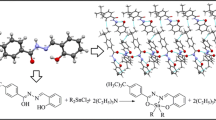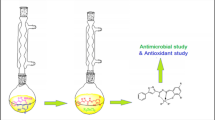Abstract
Homobimetallic organotin(IV) carboxylates dithiocarboxylates, Ph2SnLCS2Sn(Cl)Ph2 (1) and Ph3SnHLCS2SnPh3 (2) were synthesized by a room temperature reaction of l-lysine monohydrate (H2LH) with potassium hydroxide, carbon disulfide and Ph3SnCl/Ph2SnCl2 in methanol. Heterotrinuclear complexes (Bu2SnLCS2)2Pd (3) and (Bu2SnLCS2)2Pd (4) were also synthesized by a reaction of H2LH with KOH, CS2 and PdCl2(aq) in methanol followed by the treatment with n-Bu2SnCl2/Ph2SnCl2. The products were characterized by elemental analysis, FT-IR, multinuclear NMR (1H, 13C and 119Sn) and electron ionization mass spectroscopy (EIMS). The elemental analysis and mass spectrometry verified the molecular composition and structures of complexes. FT-IR spectroscopy demonstrated monodentate binding behavior of the carboxylate group and chelating mode of the dithiocarbamate moiety. The diorganotin(IV) derivatives 1, 3 and 4 convert their solid-state tetra-coordinated structures into trigonal bipyramidal arrangements in solution. However, triphenyltin(IV) derivative 2 exhibited penta-coordinated environment around Sn(IV) in the solid-state and tetrahedral configuration in the solution form. A square planar environment around Pd(II) was exhibited in the solid state. The investigated products displayed antibacterial/antifungal potential, and their minimal inhibitory concentrations (MIC) values were also demonstrated. The nature of the coordinated metals (Sn + Sn or Sn + Pd) and the substitution pattern at tin play a major role in biological actions of these products. The heterometallic (Pd, Sn) products possessed more potential against fungi than bacteria. The heterobimetallic dibutyltin(IV) complex 3 has shown the lowest hemolytic activity (10.76%), while its phenyltin(IV) counterpart 4 possessed the highest cytotoxicity (50.11%).





Similar content being viewed by others
References
Adeyemi, J.; Onwudiwe, D.; Ekennia, A.; Anokwuru, C.; Nundkumar, N.; Singh, M.; Hosten, E.C.: Synthesis, characterization and biological activities of organotin(IV) diallyldithiocarbamate complexes. Inorganica Chim. Acta. 485, 64–72 (2019)
Hussain, S.; Ali, S.; Shahzadi, S.; Tahir, M.N.; Shahid, M.: Synthesis, characterization, biological activities, crystal structure and DNA binding of organotin (IV) 5-chlorosalicylates. J. Coord. Chem. 68, 2369–2387 (2015)
Barbosa, A.S.L.; de Siqueira Guedes, J.; da Silva, D.R.; Meneghetti, S.M.P.; Meneghetti, M.R.; da Silva, A.E.; de Araujo, M.V.; Alexandre-Moreira, M.S.; de Aquino, T.M.; Siqueira Junior, J.P.: Synthesis and evaluation of the antibiotic and adjuvant antibiotic potential of organotin(IV) derivatives. J. Inorg. Biochem. 180, 80–88 (2018)
Xu, J.; Zhang, C.; Qu, H.; Tian, C.: Zinc hydroxystannate and zinc stannate as flame-retardant agents for flexible poly (vinyl chloride). J. Appl. Polym. Sci. 98, 1469–1475 (2005)
Katari, N.K.; Srinivas, K.: A novel approach to the synthesis of aryldithiocarbamic acid esters with arylamines and CS2 in aqueous media. Adv. Appl. Sci. Res. 5, 349–355 (2014)
Shaheen, F.; Zia-Ur-Rehman,; Ali, S.; Meetsma, A.: Structural properties and antibacterial potency of new supramolecular organotin(IV) dithiocarboxylates. Polyhedron 31, 697–703 (2012)
Tariq, M.; Ali, S.; Muhammad, N.; Shah, N.A.; Sirajuddin, M.; Tahir, M.N.; Khalid, N.; Khan, M.R.: Biological screening, DNA interaction studies, and catalytic activity of organotin(IV) 2-(4-ethylbenzylidene)butanoic acid derivatives: synthesis, spectroscopic characterization, and X-ray structure. J. Coord. Chem. 67, 323–340 (2014)
Ramasamy, K.; Kuznetsov, V.L.; Gopal, K.; Malik, M.A.; Raftery, J.; Edwards, P.P.; O’Brien, P.: Organotin dithiocarbamates: single-source precursors for tin sulfide thin films by aerosol-assisted chemical vapor deposition (AACVD). Chem. Mater. 25, 266–276 (2013)
Sahin, O.; Ozdemira, U.O.; Seferoglub, N.; Genc, Z.K.; Kayad, K.; Aydınera, B.; Tekine, S.; Seferoglua, Z.: New platinum (II) and palladium (II) complexes of coumarin-thiazole Schiff base with a fluorescent chemosensor properties: synthesis, spectroscopic characterization, X-ray structure determination, in vitro anticancer activity on various human carcinoma cell lines and computational studies. J. Photoch. Photobio. B 178, 428–439 (2018)
Powers, D.C.; Ritter, T.: Bimetallic Pd (III) complexes in palladium-catalysed carbon–heteroatom bond formation. Nat. Chem. 1, 302–309 (2009)
Ma, D.Y.; Zhang, L.X.; Rao, X.Y.; Wu, T.L.; Li, D.H.; Xie, X.Q.: Synthesis, characterization, luminescence, antibacterial, and catalytic activities of a palladium(II) complex involving a Schiff base. J. Coord. Chem. 66, 1486–1496 (2013)
Kumar, V.A.; Sarala, Y.; Siddikha, A.; Vanitha, S.; Babu, S.; Reddy, A.V.: Synthesis, Characterization Antimicrobial and Antioxidant Activities of 2,4-dihydroxybenzaldehyde-4-phenyl-3-thiosemicarbazone (DHBPTSC) and its Pd(II), Ni(II)dppm Mixed ligand and Cu(II) complex having heterocyclic bases. J. Appl. Pharm. Sci. 8(04), 071–078 (2018)
Caires, A.C.: Recent advances involving palladium (II) complexes for the cancer therapy, Anti-cancer agents in medicinal chemistry (formerly current medicinal chemistry-anti-cancer agents. Anti-Cancer Agents Med. Chem. 7, 484–491 (2007)
Garoufis, A.; Hadjikakou, S.; Hadjiliadis, N.: Palladium coordination compounds as anti-viral, anti-fungal, anti-microbial and anti-tumor agents. Coord. Chem. Rev. 253, 1384–1397 (2009)
Hussain, S.; Ali, S.; Shahzadi, S.; Sharma, S.K.; Qanungo, K.; Bukhari, I.H.: Homobimetallic complexes containing Sn (IV) with acetylene dicarboxylic acid: their syntheses and structural interpretation by spectroscopic, semi-empirical, and DFT techniques. J. Coord. Chem. 65, 278–285 (2012)
Bushra, P.; Hussain, B.I.; Shabbir, H.; Ghulam, A.K.; Muhammad, S.: Synthesis and spectroscopic characterization of mononuclear/binuclear organotin (IV) complexes with 1H-1, 2, 4-triazole-3-thiol&58; Comparative studies of their antibacterial/antifungal potencies. J. Serb. Chem. Soc. 80, 755–766 (2015)
Hussain, S.; Bukhari, I.H.; Ali, S.; Shahzadi, S.; Shahid, M.; Munawar, K.S.: Synthesis and spectroscopic and thermogravimetric characterization of heterobimetallic complexes with Sn (IV) and Pd (II); DNA binding, alkaline phosphatase inhibition and biological activity studies. J. Coord. Chem. 68, 662–677 (2015)
Hussain, S.; Ali, S.; Shahzadi, S.; Shahid, M.: Heterobimetallic complexes containing Sn (IV) and Pd (II) with 4-(2-Hydroxyethyl) piperazine-1-carbodithioic acid: synthesis, characterization and biological activities. Cogent Chem. 1, 1029038 (2015)
Karenina, M.; Rosario, C.: Heterobimetallic complexes of tin: synthesis and dynamic behavior. VDM Verlag Dr. Müller, Paperback (2011)
Iram, S.; Ali, S.; Shahzadi, S.: Synthesis, characterization, and antimicrobial activity of heterobimetallic complexes of Sn(IV) and Zn(II) with 4-aminophenylacetic acid. Russ. J. Gen. Chem. 83, 2453–2459 (2013)
Sharma, K.; Fahmi, N.; Singh, R.V.: Synthesis, characterization and toxicity of new heterobimetallic complexes of platinum(II) and palladium(II). Appl. Organomet. Chem. 15, 221–226 (2001)
Vaz, R.H.; Abras, A.; Silva, R.M.: Oxidation addition of tin thiolates yielding new Sn-Pt heterobimetallic complexes. J. Braz. Chem. 9, 57–62 (1998)
Gupta, A.N.; Kumar, V.; Singh, V.; Rajput, A.; Prasad, L.B.; Drew, M.G.B.; Singh, N.: Influence of functionalities on the structure and luminescent properties of organotin(IV) dithiocarbamate complexes. J. Organomet. Chem. 787, 65–72 (2015)
Morita, T.; Arai, T.; Sasai, H.; Shibasaki, M.: Utilization of heterobimetallic complexes as Lewis acids. Tetrahedron Asymmetry 9, 1445–1450 (1998)
Deng, Y.; Karunaratne, C.; Csatary, E.; Tierney, D.L.; Wheeler, K.; Wang, H.: Chiral bimetallic catalysts derived from chiral metal phosphates: enantioselective three-component asymmetric aza diels alder reactions of cyclic ketones. J. Org. Chem. 80(16), 7984–7993 (2015)
Ferraresso, L.G.; de Arruda, E.G.R.; de Moraes, T.P.L.; Fazzi, R.B.; Da Costa Ferreira, A.M.; Abbehausan, C.: Copper(II) and zinc(II) dinuclear enzymes model compounds: the nature of the metal ion in the biological function. J. Mol. Struct. 1150, 316–328 (2017)
ArafatY, Ali S.; Shahzadi, S.; Shahid, M.: Preparation, characterization, and antimicrobial activities of bimetallic complexes of sarcosine with Zn(II) and Sn(IV). Bioinorg. Chem. Appl. 2013, 351262 (2013)
Tome, d; Bos, C.: Lysine requirement through the human life cycle. J. Nutr. 137, 1642S–1645S (2007)
Tanphaichitr, V.; Broquist, H.P.: Role of lysine and -N-trimethyllysine in carnitine biosynthesis. II. Studies in the rat. J. Biol. Chem. 248, 2176–2181 (1973)
Brautaset, T., Ellingsen, T.E.; Eggeling, L. Lysine industrial uses and production. In book: Reference Module in Life Sciences. (2017). https://doi.org/10.1016/b978-0-12-809633-8.09172-x.
Armarego, W.L.; Chai, C.L.L.: Purification of laboratory chemicals. Butterworth-Heinemann, Oxford (2013)
Fritsche, T.R.; McDermott, P.F.; Shryock, T.R.; Walker, R.D.: Agar dilution and disk diffusion susceptibility testing of Campylobacter spp. J. Clin. Microbiol. 45, 2758–2759 (2007)
Sarker, S.D.; Nahar, L.; Kumarasamy, Y.: Microtitre plate-based antibacterial assay incorporating resazurin as an indicator of cell growth, and its application in the in vitro antibacterial screening of phytochemicals. Methods 42, 321–324 (2007)
Sharma, P.; Sharma, J.D.: In vitro hemolysis of human erythrocytes—by plant extracts with antiplasmodial activity. J. Ethnopharmacol. 74, 239–243 (2001)
Eng, G.; Song, X.; Zapata, A.; de Dios, A.C.; Casabianca, L.; Pike, R.D.: Synthesis, structural and larvicidal studies of some triorganotin 2-(p-chlorophenyl)-3-methylbutyrates. J. Organomet. Chem. 692, 1398–1404 (2007)
Faraglia, G.; Fregona, D.; Sitran, S.; Giovagnini, L.; Marzano, C.; Baccichetti, F.; Casellato, U.; Graziani, R.: Platinum (II) and palladium (II) complexes with dithiocarbamates and amines: synthesis, characterization and cell assay. J. Inorg. Biochem. 83, 31–40 (2001)
Hussain, S.; Ali, S.; Shahzadi, S.; Sharma, S.K.; Qanungo, K.; Altaf, M.; Evans, H.S.: Synthesis, characterization, and semi-empirical study of Organotin (IV) complexes with 4-(Hydroxymethyl) piperidine-1-carbodithioic Acid: x-ray structure of Chlorodimethyl-(4-hydroxymethyl piperidine-1-carbodithioato-S, S′) tin (IV). Phosphorus, Sulfur, Silicon. Relat. Elem. 186, 542–551 (2011)
Bonati, F.; Ugo, R.: Organotin (iv) n, n-disubstituted dithiocarbamates. J. Organomet. Chem. 10, 257–268 (1967)
Hussain, S.; Ali, S.; Shahzadi, S.; Rizzoli, C.; Shahid, M.: Diorganotin (IV) complexes with monohydrate disodium salt of iminodiacetic acid: synthesis, characterization, crystal structure and biological activities. J. Chin. Chem. Soc. 62, 793–802 (2015)
Shahzadi, S.; Ali, S.: Structural chemistry of organotin(IV) complexes. J. Iran. Chem. Soc. 5, 16–28 (2008)
Hussain, S.; Saqib, S.; Shahzadi, S.; Sharma, S.K.; Qanungo, K.; Shahid, M.: Synthesis, characterization, semiempirical and biological activities of organotin(iv) carboxylates with 4-piperidinecarboxylic acid. Bioinorg. Chem. Appl. 2014, 959203 (2014)
Eng, G.; Song, X.; Zapata, A.; de Dios, A.C.; Casabianca, L.; Pike, R.D.: Synthesis, structural and larvicidal studies of som triorganotin 2-(p-chlorophenyl)-3-methylbutyrates. J. Organomet. Chem. 692(6), 1398–1404 (2007)
Baul, T.S.B.; Dhar, S.; Pyke, S.M.; Tiekink, E.R.T.; Rivarola, E.; Butcher, R.; Smith, F.E.: Synthesis and characterization of triorganotin(IV) complexes of 5-[(E)-2-(aryl)-1-diazenyl]-2-hydroxybenzoic acids.: crystal and molecular structures of a series of triphenyltin 5-[(E)-2-(aryl)-1-diazenyl]-2-hydroxybenzoates (aryl = phenyl, 2-methylphenyl, 3-methylphenyl and 4-methoxyphenyl). J. Organomet. Chem. 633, 7–17 (2001)
Tarassoli, A.; Sedaghat, T.; Neumüller, B.; Ghassemzadeh, M.: Synthesis, spectroscopic investigations and crystal structures of organotin(IV) derivatives of 2-amino-1-cyclopentene-1-carbodithioic acid. Inorg. Chim. Acta 318, 15–22 (2001)
Aziz-ur-Rehman, A.; Hussain, M.; Zia-ur-Rehman, A.; Ali, S.; Rauf, A.; Nasim, F.; Helliwell, M.: Self-assembled pentagonal bipyramidal and skew trapezoidal organotin(IV) complexes of substituted benzoic acids: their antibacterial, antifungal, cytotoxic, insecticidal and urease inhibition activities. Inorg. Chi. Acta. 370, 27–35 (2011)
Shahzadi, S.; Shahid, K.; Ali, S.: Spectral characterization and biocidal activity of organotin (IV)(E)-3-[(2′, 6′-dichlorophenylamido)] propenoates. J. Coord. Chem. 60, 2637–2648 (2007)
World Health Organization Global action plan on antimicrobial resistance. WHO Press 1–28 (2015).
Adeyemi, J.; Onwudiwe, D.C.: Review organotin(IV) dithiocarbamate complexes: chemistry and biological activity. Molecules 23, 2571 (2018)
Sharma, N.; Kumar, V.; Kumari, M.; Pathania, A.; Chaudhry, S.C.: Synthesis, characterization, and antibacterial activity of triorganotin(IV) complexes of 2-methylphenol. J. Coord. Chem. 63, 3498–3515 (2010)
Khan, N.; Farina, Y.; Mun, L.K.; Rajab, N.F.; Awang, N.: Syntheses, spectral characterization, X-ray studies and in vitro cytotoxic activities of triorganotin(IV) derivatives of p-substituted N-methylbenzylaminedithiocarbamates. J. Mol. Struct. 1076, 403–410 (2014)
Rehman, A.; Siddiqui, S.Z.; Abbasi, M.A.; Abbas, N.; Khan, K.M.; Shahid, M.; Mahmood, Y.; Akhtar, M.N.; Lajis, N.H.: Synthesis, antibacterial screening and hemolytic activity of S-substituted derivatives of 5-benzyl-1, 3, 4-oxadiazole-2-thiol. Int. J. Pharm. Pharm. Sci. 4, 676–680 (2012)
Kadu, R.; Roy, H.; Singh, V.K.: Diphenyltin(IV) dithiocarbamate macrocyclic scaffolds as potent apoptosis inducers for human cancer HEP 3B and IMR 32 cells: synthesis, spectral characterization, density functional theory study and in vitro cytotoxicity. Appl. Organomet. Chem. 29, 746–755 (2015)
Mariam, S.; Hussain, S.; Ali, S.; Shahzadi, S.; Ramzan, S.; Shahid, M.: Homobimetallic (Sn, Sn) complexes with [2-Dithiocarboxy(methyl)amino]acetic acid: synthesis, characterization and biological studies. Iran J Sci Technol Trans Sci. 42, 1277–1284 (2018)
Yin, H.D.; Xue, S.C.: Synthesis and characterization of organotin complexes with dithiocarbamates and crystal structures of (4-NCC6H4CH2)2Sn(S2CNEt2)2 and (2-ClC6H4CH2)2 Sn(Cl)S2CNBz2. Appl. Organomet. Chem. 20, 283–289 (2006)
Awang, N.; Baba, I.; Yamin, B.M.; Othman, M.S.; Kamaludin, N.F.: Synthesis, characterization and biological activities of organotin (IV) methylcyclohexyldithiocarbamate compounds. Am. J. Appl. Sci. 8(4), 310–317 (2011)
Author information
Authors and Affiliations
Corresponding author
Rights and permissions
About this article
Cite this article
Hussain, S., Zahid, Z., Shahid, M. et al. Synthesis, Spectroscopic and Antimicrobial Studies of Homo- and Heteronuclear Tin(IV)/Pd(II) Complexes of 2-Amino-6-(Dithiocarboxyamino)Hexanoic Acid. Arab J Sci Eng 44, 6423–6434 (2019). https://doi.org/10.1007/s13369-019-03938-z
Received:
Accepted:
Published:
Issue Date:
DOI: https://doi.org/10.1007/s13369-019-03938-z




